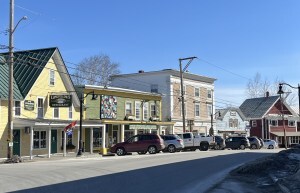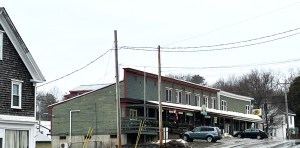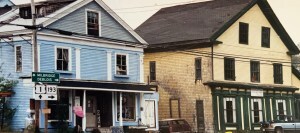Why use a fictional town instead of real town in a mystery?
One question I get asked with surprisingly frequency is why I use a fictional town in my books instead of a real one. Many readers who ask are also under the impression even though my town, Redimere, Maine, doesn’t exist, it’s still “based” on a town in Franklin County, and they want to know which one.
This question is often from people who live in Maine, particularly those familiar with Franklin County, which is in the northwest corner of the state. But, surprisingly, it also comes from people who don’t live there, or aren’t even familiar with it.
First, it’s important to know that — like characters — my town isn’t “based” on any town. Instead, it’s inspired by many towns, some not even in Franklin County. It may be hard people who don’t write or create other art to fully grasp the concept of inspiration vs. direct depiction of reality. It’s also a hard concept to explain to people’s satisfaction, I’ve discovered. The way it works is that different elements, big and small, interest me or seem to work. They spark something in my imagination. They come together in my mind to form an entity that’s very real in my head and unlike any of them, but inspired by all of them. That goes for characters, and it goes for Redimere.
When I first started writing Cold Hard News, the first in my Bernadette “Bernie” O’Dea mystery series, it was set in Waldo County. The town of Brooks inspired some elements. I moved Redimere to Franklin County sometime during the revision process (a story for another day). Franklin County towns like Kingfield, Phillips, Strong and Stratton also came into the mix. On top of it, one day back in the 1990s, a decade before I actually began writing, I was thinking about my future book as I drove through Cherryfield, way Down East, in Washington County. I took some photos (with a film camera!) because I thought its downtown was evocative of the one in the mystery novel I planned to write. In particular, a large clapboard yellow building seemed to be similar to the newspaper building in my imagination. That building, with some small tweaks to the front windows and door, is very like the one that the Weekly Watcher newspaper in my books operates out of (Bernie O’Dea is the editor and owner).

Kingfield is a real town in Franklin County. Redimere, my fictional town, is not based on it, but just like it in the way that towns in that area are.
Redimere is not Brooks or Cherryfield. It’s not Kingfield or Phillips or Stratton. It’s not the town I live in. It’s a town in my imagination that is inspired by things that were ticked by these towns. The things that happen in Redimere aren’t “based on” things that happen in those towns (I barely know what happens in those towns!). They’re also not based in any way, shape or form on anything that happens in the town I live in. I learned at

Brooks, a town in Waldo County, provided some inspiration, particularly this store, which is a lot like The Country Grocer in my books. (It’s no longer a store, I know, so don’t email me).
a young age that you don’t [poop] where you eat. I take that to heart.
Now, with that background, the actual answer to the question is that it’s virtually impossible to use a real town as the center of action in fiction without also stifling imagination. At least it is for me. I’m not talking about setting a book in city, like New York or Los Angeles or Boston, or even Portland. Maybe even Augusta (my

I took photos of Cherryfield, in Washington County, back in the 1990s, thinking it had some similarities to the downtown of my future mystery novels. The yellow building is an inspiration for the Weekly Watcher newspaper building in my books.
hometown, population 18,000). I’m talking about an existing smaller town or small city.
While most of my readers don’t live in, or are not familiar with, Franklin County, those who do, or are, would assume even more than they already do that the characters are based on real people and situations. That the stories are thinly veiled commentary on town happenings. This doesn’t just go for Franklin County, it’s also true of the Kennebec County town I live in. While I know this doesn’t apply to the vast majority of those who read my books, I still have a fact-obsessed enough brain to not want it to happen.
Bigger-picture, if I stuck my plots and characters in a real, but small, geography, it would push the writing into a framework that would be stifling. I can bend a fictional town to my will. It makes for a much more creative and expansive writing process. I’d stumble and stall a lot if I had to exist in a real framework. I could add fictional elements to the real town, but I have trouble doing that. Maybe it’s a lifetime as a journalist, that I just can’t put fake things into reality. Some of it, too, is that I know it would lead to more consternation on the part of people familiar with the town. That road doesn’t exist! There was never a store like that in that town! Etc. The situation would be even worse when writing about actions of the town government, the post mistress, the businesses in town.
Beyond all that, why limit myself to a framework, even if I’m going to make it flexible, when I can create my own and make it do what I want? Imagination is gonna imagine. Trying to tame it so that it fit into a box that I didn’t create would not be fun, or conducive to good writing.
My town of 2,000 is bigger than any of those, more than double, that exist in that part of Franklin County. It has a small college. Readers have pointed out to me that, aside from the University of Maine-Farmington, there is no college like that in Franklin County. No, there’s not. But there is in my books, because fiction is fiction. I needed a town big enough that it would have, besides the college, some commerce and other elements that would support the books’ plots as well as a police department and a newspaper.
As a reader, I used to try to figure out where fictional towns set in real places were. It was a frustrating exercise. As a writer, I now know why that’s the case. My town’s location is in the general area of central-north Franklin County, but it’s hard to pin it down to a specific spot. I’ve made up a river, and a state route, in order to make the vague location less pinned to reality. That’s not because I want to screw around with readers, but more so that I can free myself from the constraints of reality when I form my plots or scenes in which geography has an impact.

Why have a map of a fictional town? Why not? From The Bernie O’Dea Reader’s Companion.
In my recently published The Bernie O’Dea Reader’s Companion, there’s a map I’ve created of Redimere, as well as one of the area around the town. It may seem counter-intuitive to have a map of a fake place in a real area, but I’ve used two similar, but much cruder, ones to help me keep things straight when I write. Still, I tell readers of that book, this may not match reality as you know it, or even imagine it.
All that said, I do use real towns and cities in the books. Farmington, the county seat and, at 8,000, Franklin County’s most populous, is where real people and those in Redimere go for services. I also refer to Kingfield, Stratton, Carrabassett Valley, and other towns to make Redimere seem more real and give an idea for those who are familiar of its general location. I make up surrounding towns, too, like West Vineyard, as part of the fiction and plot process. In real life, there’s a New Vineyard, which I also refer to briefly, but no West Vineyard. Again, I’m not trying to play head games with people who live there or are familiar with the area, just creating my fictional world.
I know, as a reader, it can be hard to let fiction be fiction sometimes. On the other hand, I know readers have great imaginations, and as long as the tell themselves that fiction IS fiction, then Redimere, Maine, can exist right along with the real Franklin County.
Lea Wait's Blog
- Lea Wait's profile
- 508 followers



